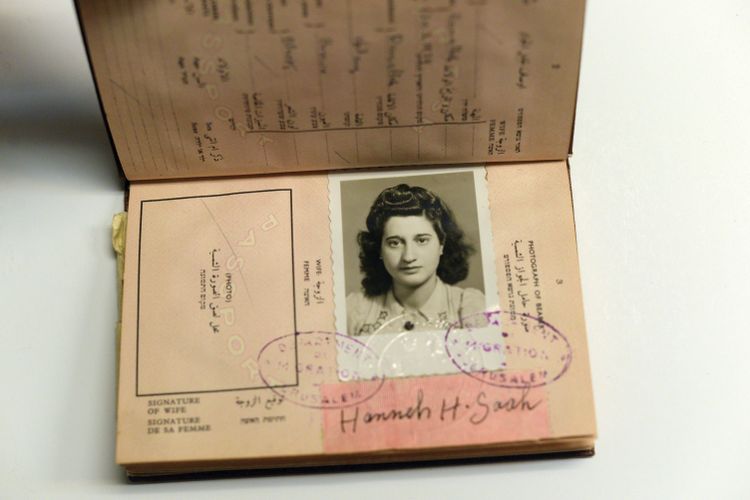ART WORLD NEWS
New museum tells Palestinian stories in the centre of US politics
[ad_1]
Exhibits include a 1946 British Mandate passport, issued to Palestinians during the existence of Mandatory Palestine, from 1929 until the creation of Israel in 1948
Courtesy of James F. Saah and family
A week before the White House unveiled a $50bn economic plan aimed at kickstarting the Israeli-Palestinian peace process, the Museum of the Palestinian People (MPP) quietly opened in Washington, DC. The 800 sq. ft private museum, located three miles from Capitol Hill, was inaugurated on 15 June with a small gathering of attendees and no protests, according to a museum spokeswoman.
“When I first moved to Washington in 2011, there was simply no place to hear or see the stories of Palestinians,” says the museum’s founder and director Bshara Nassar, a Bethlehem-born Palestinian. “For too long our stories have been told by others, who portray us in often-negative stereotypes.” He had the idea for a permanent space after organising an exhibition about Palestinian culture that opened in Washington, DC, in 2015 and travelled to more than 50 locations in the US.
“There is certainly room for a more nuanced understanding of the Middle East in the US, and this museum and other similar initiatives can play a role in this regard,” says Sultan Sooud Al Qassemi, an Emirati lecturer in Middle Eastern art and politics and the founder of Sharjah’s Barjeel Art Foundation.
Nassar says that “an American family who really cares about Palestinians having a voice in our nation’s capital” have lent the current space, and the museum raised an additional $200,000 of private funding. The MPP “has been supported over the last four years by thousands of American, Jewish, Palestinian and other international donors”, according to a press statement.
The permanent displays of gifts and long-term loans include everyday objects such as ceramics, archival materials from the 20th century including photographs and passports, and contemporary works by artists such as the New York-based abstract painter Samia Halaby. The small inaugural temporary show, Re-imagining a Future, on view until the end of the year, includes ten works by contemporary Palestinian artists from the US, Canada, the West Bank, Gaza and Israel.
The MPP was initially conceived as a commemoration of the Nakba, the Arabic word for “catastrophe” used by Palestinians to describe the mass exodus from the region after Israel was founded in 1948. (Marking Nakba Day is a criminal offence in Israel.) Nassar says he later decided to “expand the story to show our culture and art, and not focus on one event in Palestinian history”, although a section of the museum’s displays is dedicated to the event.
We think it is very important to demonstrate Palestinian unity in the face of the challenges Palestinians face
Faisal Saleh, Palestinian-American entrepreneur
“One can’t imagine that a museum focusing on Palestinian people would be doing its job without adequately capturing the Nakba as one of the most seismic moments in our modern history,” says Christopher Khoury, the son of the late Palestinian-American artist Sari Ibrahim Khoury, whose work is on view at the MPP. The Jewish Community Relations Council of Greater Washington, an Israel advocacy group, declined to comment on the opening of the museum and its use of the word Nakba.
The MPP is the second Palestinian museum to open in the US, following the Palestine Museum US, a 6,000 sq. ft private institution launched in Connecticut in 2018. Although much larger, it shares the MPP’s mission, says its founder, the Palestinian-American entrepreneur Faisal Saleh. “We think it is very important to demonstrate Palestinian unity in the face of the challenges Palestinians face,” says Saleh, who has proposed merging the two institutions, but had not yet received a response from the MPP at the time of publication.
The location of the MPP has generated discussion. Halaby, who is also an influential scholar of Palestinian art, says that while she supports the museum’s principles, she wonders: “Is it in Washington as soft propaganda to influence the US government? Are there not larger Palestinian communities in Ohio and New Jersey?”
Others believe that being close to the centre of US politics is key. “It is important to humanise the Palestinian people and introduce their story to US audiences, as well as to the policy community,” says Lyne Sneige, the director of the arts and culture programme at the Middle East Institute in Washington, DC, which is due to open a gallery for contemporary Middle Eastern art in September.
“So much of our destiny has been dominated by the machinations happening in our capital,” Khoury says. “Now is as good a time as ever to begin turning that logic around and reclaiming our narrative.”
[ad_2]
Source link













